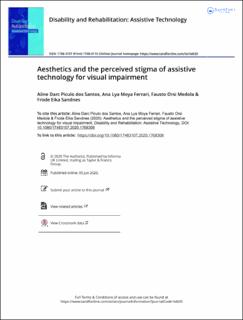| dc.contributor.author | Santos, Aline Darc Piculo | |
| dc.contributor.author | Ferrari, Ana Lya M. | |
| dc.contributor.author | Medola, Fausto Orsi | |
| dc.contributor.author | Sandnes, Frode Eika | |
| dc.date.accessioned | 2022-03-14T11:56:56Z | |
| dc.date.available | 2022-03-14T11:56:56Z | |
| dc.date.created | 2020-12-11T10:20:53Z | |
| dc.date.issued | 2020 | |
| dc.identifier.citation | Disability and Rehabilitation: Assistive Technology. 2020, 17 (2), 152-158. | en_US |
| dc.identifier.issn | 1748-3107 | |
| dc.identifier.uri | https://hdl.handle.net/11250/2985065 | |
| dc.description.abstract | The aim of this study was to identify factors that influence the perceived stigma of two assistive devices for visual impairment, namely the white cane and smart glasses. Method: Face-to-face semi-structured interviews with eight European students were conducted to probe their experiences and knowledge related to disability, assistive technology, visual impairment, as well as handheld and wearable devices. Results: Close relationships with disabled people seems to have a positive influence on participants perceptions about stigma, disability, and assistive technology. Academic background seems to not have any influence. The aesthetics of assistive devices was observed as an important factor that influences the adoption or abandonment of the device. Conclusion: Device without negative symbolism but with modern aesthetics (smart glasses) were positively accepted by the participants than the device with traditional aesthetics and symbolisms of visual impairment (white cane). Designers should, therefore, consider aesthetics in addition to functionality in order to avoid the perceived stigma, thereby reducing the chances of device abandonment | en_US |
| dc.language.iso | eng | en_US |
| dc.publisher | Taylor & Francis | en_US |
| dc.rights | Attribution-NonCommercial-NoDerivatives 4.0 Internasjonal | * |
| dc.rights.uri | http://creativecommons.org/licenses/by-nc-nd/4.0/deed.no | * |
| dc.subject | Assistive technology | en_US |
| dc.subject | Stigma | en_US |
| dc.subject | Visual impairment | en_US |
| dc.subject | Smart glasses | en_US |
| dc.subject | White cane | en_US |
| dc.title | Aesthetics and the perceived stigma of assistive technology for visual impairment | en_US |
| dc.type | Peer reviewed | en_US |
| dc.type | Journal article | en_US |
| dc.description.version | publishedVersion | en_US |
| cristin.ispublished | true | |
| cristin.fulltext | original | |
| cristin.fulltext | postprint | |
| cristin.fulltext | original | |
| cristin.qualitycode | 1 | |
| dc.identifier.doi | 10.1080/17483107.2020.1768308 | |
| dc.identifier.cristin | 1858627 | |
| dc.source.journal | Disability and Rehabilitation: Assistive Technology | en_US |
| dc.source.volume | 17 | en_US |
| dc.source.issue | 2 | en_US |
| dc.source.pagenumber | 152-158 | en_US |

